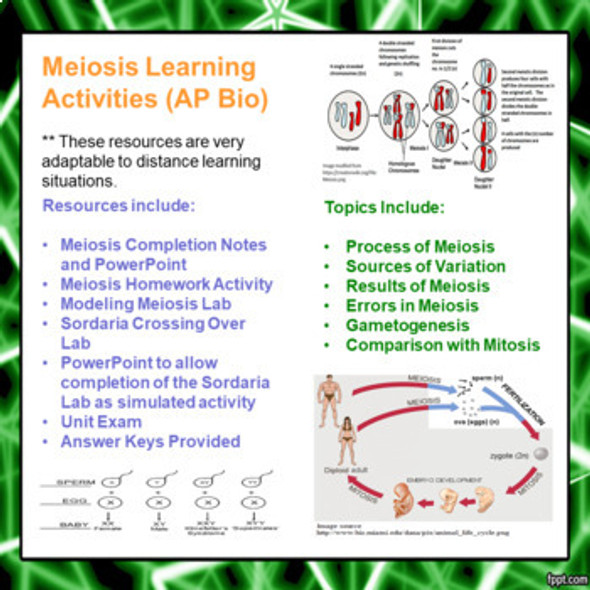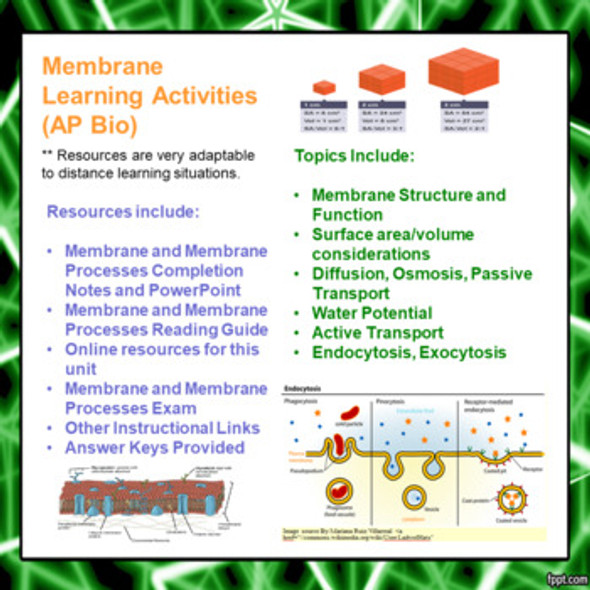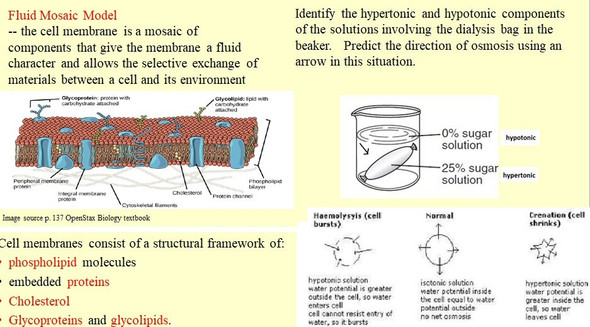Endocrine and Feedback Mechanisms Learning Activities for AP Biology (Distance Learning)
- Bulk Pricing:
- Buy in bulk and save
- Contributor:
- Monday's Rescue
- Grade Level:
- 9-12
- Product Type:
- Learning Package (Notes, PowerPoint, Case Study, Homework)
- File Type:
- doc, pdf, ppt
- Pages:
- 38
- Answer Key:
- Yes
Description
This zip file contains many different activities (36 pages of student handouts and 2 PowerPoint with a total of 43 slides) which can be used to compose a unit for AP Biology or advanced Biology students involving aspects of endocrine anatomy and physiology. Some topics addressed in this unit include categories of endocrine hormones and how they trigger activities within a cell or target organ/ The hypothalmus and its role, major pituitary, thyroid, parathyroid, adrenal, pancreatic and reproductive hormones are also addressed. Many other topics pertinent to this unit are discussed. More specifics on the learning goals addressed in this learning package may be viewed near the end of this course description.
The topic of feedback mechanisms may be taught separately in the revised 2019-2020 AP Biology curriculum. With that in mind, a separate PowerPoint and set of associated completion notes has been included in this package for teachers that only wish to address those points tested on the AP exam. The learning objectives have been revised to reflect the changes in the 2019-2020 curriculum.
While these lessons were originally designed for my AP Biology curriculum, they can be adapted to any advanced level Biology program. The reading worksheet included links to an Openstax textbook which is free for use by any Biology student or teacher. This text can be used to replace a traditional (and often pricey) classroom textbook.
This lesson packet contains a listing of the learning goals, common core learning standards, NGSS learning standards and the AP Biology performance indicators addressed in these materials. These are included in the packet and at the end of the description of this lesson.
The components of this lesson package can easily be displayed to students using an LCD projector and may be readily modified into formats facilitating smartboard technology. Most documents are included in both word and pdf format to allow editing for specific teacher needs.
Answer keys are included for all listed student work items. Files have been provided in both editable word and pdf format to allow you to edit the activities to meet the needs of the students in your classroom.
The specific contents of the learning package includes the following items (the page count for these items are actual student handouts as answer key page counts are not included):
-- Learning Goals, NGSS Correlations, ETS AP Biology and Common Core Learning standards correlations (3 pages)
-- Endocrine Completion Notes (6 pages)
-- PowerPoint to accompany the Completion Notes (32 slides)
-- Feedback Mechanisms PowerPoint (11 slides)
-- Completion Notes to accompany the Feedback Mechanisms PowerPoint (3 pages)
-- Endocrine Reading Worksheet (6 pages) (includes 36 short answer questions)
-- Endocrine Worksheet (2 pages) (provides a diagram and graphic organizer to review the major endocrine glands and its hormones)
-- Endocrine/Nervous Case Studies Activity with Key (11 pages)-- Links to Endocrine Resources from other websites (1 page)
-- Endocrine Exam with answer key (4 pages)
ETS AP Biology Learning Objectives
Enduring Understanding
ENE-3 Timing and coordination of biological mechanisms involved in growth, reproduction, and homeostasis depend on organisms responding to environmental cues.
Learning Objectives
ENE-3.A Describe positive and/ or negative feedback mechanisms.
ENE-3.B Explain how negative feedback helps to maintain homeostasis.
ENE-3.C Explain how positive feedback affects homeostasis.
Feedback Mechanisms and the Endocrine System Objectives (local)
Upon the completion of the text reading and discussion of this information, the student will be able to:
1. explain how secretions of the endocrine glands reach their target cells.
2. describe the relationships among endocrine system components: hormones, endocrine glands, target cells, and target cell receptors.
3. list the general chemical classes of hormones and give examples of each.
4. state which of the two classes of hormones is lipid soluble, and explain how this property affects hormone function.
5. describe the mechanisms of peptide and steroid hormone action.
6. explain what is meant by negative feedback and describe two examples of negative feedback mechanisms in human blood sugar regulation.
7. describe the location and role of the hypothalamus.
8. describe the location of the pituitary, and list the major hormones and functions of its posterior and anterior lobes.
9. discuss positive feedback mechanism and discuss three examples of these.
10. list hormones of the thyroid gland, and explain their role in development and metabolism.
11. state the location of the parathyroid glands, and describe hormonal control of calcium homeostasis.
12. list two hormones of the adrenal glands, describe their function, and explain how their secretion is controlled.
13. distinguish between alpha and beta cells in the pancreas and explain how their antagonistic hormones (insulin and glucagon) regulate carbohydrate metabolism.
14. identify male and female gonads, and list and state the functions of three different gonadal steroid hormones.
15. discuss goiter, diabetes, and Grave's disease in reference to their causes and how these conditions disrupt homeostasis.
NGSS Standards
Students who demonstrate understanding can:
HS-LS1-2. Develop and use a model to illustrate the hierarchical organization of interacting systems that provide specific functions within multicellular organisms
HS-LS1-3. Plan and conduct an investigation to provide evidence that feedback mechanisms maintain homeostasis.
Common Core State Standards Connections:
ELA/Literacy
WHST.9-12.7 Conduct short as well as more sustained research projects to answer a question (including a self-generated question) or solve a problem; narrow or broaden the inquiry when appropriate; synthesize multiple sources on the subject, demonstrating understanding of the subject under investigation.
WHST.11-12.8 Gather relevant information from multiple authoritative print and digital sources, using advanced searches effectively; assess the strengths and limitations of each source in terms of the specific task, purpose, and audience; integrate information into the text selectively to maintain the flow of ideas, avoiding plagiarism and overreliance on any one source and following a standard format for citation.
Terms of Use
Purchase of the product is for classroom use by the purchaser only. It is a violation for individuals, schools, and districts to redistribute, sell, or post this item on the Internet or to other individuals.
This work is licensed under a Creative Commons Attribution-NonCommercial-ShareAlike 4.0 International License.
This learning package bundle is part of the AP Biology Complete Course. The complete course contains 22 learning package bundles in addition to this one. Save nearly 60% over the cost of buying 23 individual unit learning bundles with your purchase of the complete course.














